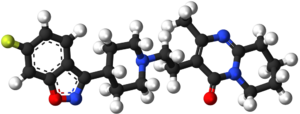Risperidone
 |
|
 |
|
| Clinical data | |
|---|---|
| Trade names | Risperdal, others |
| AHFS/Drugs.com | Monograph |
| MedlinePlus | a694015 |
| Pregnancy category |
|
| Routes of administration |
Oral (tablets and liquid form), IM |
| ATC code | |
| Legal status | |
| Legal status | |
| Pharmacokinetic data | |
| Bioavailability | 70% (oral) |
| Metabolism | Liver (CYP2D6 mediated to 9-hydroxyrisperidone) |
| Biological half-life | 20 hours (Oral), 3–6 days (IM) |
| Excretion | Urinary (70%) feces (14%) |
| Identifiers | |
|
|
| CAS Number | |
| PubChem CID | |
| IUPHAR/BPS | |
| DrugBank | |
| ChemSpider | |
| UNII | |
| KEGG | |
| ChEBI | |
| ChEMBL | |
| ECHA InfoCard | 100.114.705 |
| Chemical and physical data | |
| Formula | C23H27FN4O2 |
| Molar mass | 410.485 g/mol |
| 3D model (Jmol) | |
|
|
|
|
Risperidone, sold under the trade name Risperdal among others, is an antipsychotic medication. It is mainly used to treat schizophrenia, bipolar disorder, and irritability in people with autism. It is taken either by mouth or by injection into a muscle. The injectable version is long acting and lasts for about two weeks.
Common side effects include movement problems, sleepiness, trouble seeing, constipation, and increased weight. Serious side effects may include the potentially permanent movement disorder tardive dyskinesia, as well as neuroleptic malignant syndrome, an increased risk of suicide, and high blood sugar levels. In older people with psychosis as a result of dementia it may increase the risk of dying. It is unclear if it is safe for use in pregnancy. Risperidone is an atypical antipsychotic. Its mechanism of action is not entirely clear, but is believed to be related to its action as a dopamine antagonist.
Study of risperidone began in the late 1980s and it was approved for sale in the United States in 1993. It is on the World Health Organization's List of Essential Medicines, the most effective and safe medicines needed in a health system. It is available as a generic medication. The wholesale price in the developing world is between 0.01 and 0.60 USD per day as of 2014. As of 2015 the cost for a typical month of medication in the United States is 100 to 200 USD.
...
Wikipedia
